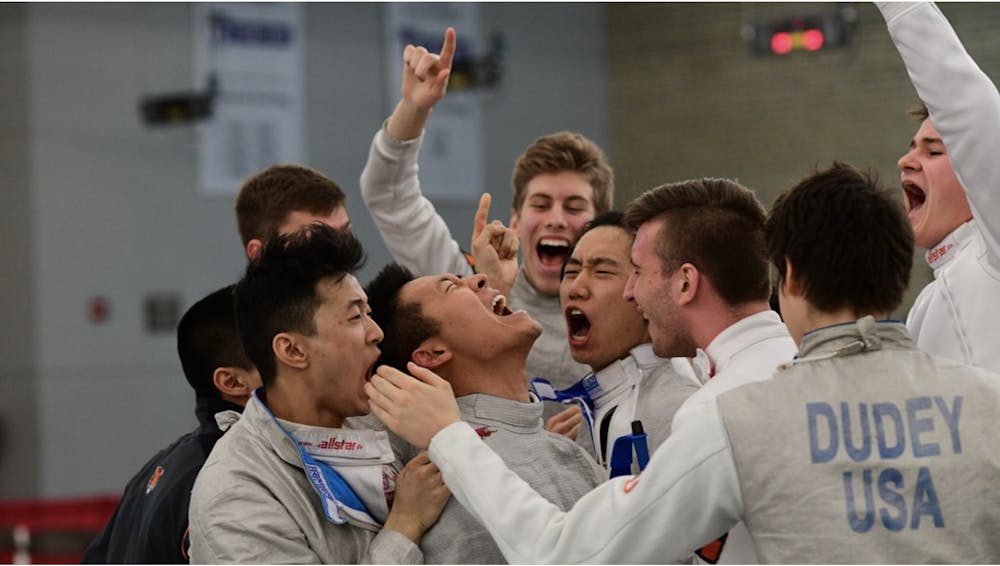“We have an excellent team but people are always surprised we have a team at all,” said Katharine Holmes ’17, a former member of Princeton’s fencing team. Holmes herself is a 2016 fencing Olympian, 2018 world champion, and currently serves as a volunteer coach for the University’s fencing teams.
In the past 10 years, Princeton’s men’s and women’s fencing teams have amassed an impressive résumé of accomplishments. The women’s team won seven of eight Ivy League titles from 2010 to 2017, the men's team won two consecutive Ivy titles in 2016 and 2017, and both finished in the top four of the NCAA Championship from 2011 to 2017, even coming in first place in 2013.
This year, epeeist Dylan Kim ’21, saberist Daniel Kwak ’21, and foilist Dolly Lampson-Stixrud ’22 have taken on the responsibility of leading one of the top fencing teams in the country.
“Physical Chess”
Kim explained that fencing’s nickname, “physical chess,” comes from the emphasis it places on strategy and technique compared to other sports.
“When people think of fencing, they think of Pirates of the Caribbean, waving swords and all that. But the modern version of fencing, the sport that we play, is actually very different,” Kim said.
Fencing is rooted in European sword fighting, but it is now governed by rules and regulations that separate it into three weapons categories: epee, foil, and saber. Not only is each weapon physically different, but they have their own distinct play style and technique.
Epee is heavier, longer, and stiffer than the other two. In order to score, there is a button on the tip of the blade that must be pressed against the target area. For epee, the entire body is valid to score on, excluding the weapon; it is possible to score on an opponent’s hand behind the guard of their blade, the mask, or even their foot.
“I've gotten hit in the crotch multiple times,” Kim admitted. “People have so many different styles in epee because you can find so many different ways to hit people when the entire body is fair game.”
When both fencers score in epee at the same time, both are awarded a point. Thus, fencers must exercise extreme patience, making sure not to give opponents an opening when attacking. These characteristics make epee unpredictable, with top-seeded epeeists sometimes losing in the first round or an underdog doing surprisingly well, according to Kim.
Foil, on the other hand, only designates the torso as a target area. Fencers may hit anywhere from the neck to the waist, except the arms and hands. The blade itself is the smallest and lightest of the three, allowing for quicker and more precise attacks than epee.
Scoring for foil is determined by the referee based on “right of way,” which is a set of rules that determines which fencer gets the point when both fencers score a touch on their opponent. This means that, unlike epee, only one point can be awarded at a time. However, this makes it vulnerable to referee bias, and they can easily sway the outcome of a bout.

“I'd say foil is the most difficult weapon to fence because it's not just you and your opponent; you also have the discrimination of the referee,” Lampson-Stixrud said.
According to Kwak, however, this is part of the game. “Try to adjust your fencing to the ref, and don't blame the results on them. Focus on being a better fencer rather than being somebody who complains.”
Saber also follows “right of way,“ but it is a very different weapon from foil. Its blade is what stands out — the guard is shaped more like a pirate cutlass than a circular disk as you would find on an epee or foil. And instead of a button at the tip of the blade as with the other two blades, the entire length of the blade can register a touch when contacted against the target area, which is anything above the waist, including the arms and mask.
“If you've watched the Three Musketeers, their fencing is more like saber because you're slashing and not just poking,” Kwak explained.
The match is often accompanied by loud, emphatic yells from the fencer after they score a point.
“You get so tense because it's just you and another guy on the strip. When you get a touch, all of that tension just loosens up and explodes from you. Obviously, it feels great,” Kim said. “It really shows the intensity of the game.”
Lampson-Stixrud added that yelling is a form of confidence in your point that can even subconsciously sway the judge’s evaluation of the point.
Team culture
Though fencing is organized both individually and in teams, it is still widely regarded as an individual sport. Kwak recalled how he had to adjust to the team environment after coming to Princeton.
“My mentality underwent a shift. These people were not my competitors anymore; they were my friends and teammates,” he explained. Over time, the Tigers have learned to celebrate individual wins like team accomplishments.
“An individual win at a tournament is a team win because for one of us to do well is a good thing for all of us,” Lampson-Stixrud said.
For example, a large distinction between the NCAA Tournament and the Ivy League Tournament is that the NCAA is entirely individual, whereas the Ivy Tournament is a team competition.
Kwak, who took second place in men’s saber at the 2019 NCAA Championship, felt that he would much rather win an Ivy League title than an NCAA one.
“There's something special about winning together as a team, and with NCAAs, you don't really get that.”
The team has reflected this camaraderie both on and off the fencing strip, Kim said.
“We have a very supportive team. Our upperclassmen are always willing to help out our underclassmen with questions about their academics, the different decisions they have to make, homework assignments, [and] problem sets.”
Fencing helped Kwak foster an intense dedication for the team that built both character and well-being. The captains agreed that much of this has been a product of the work that the fencing coaches have put into the program. For one, they said that Head Coach Zoltan Dudas is unique because of how much time he invests in each athlete’s personal health outside of the sport.
“It's a very wholesome environment. You don't feel like they're gonna put you down just because you're having an off day,” Lampson-Stixrud added.
She described how Associate Head Coach Szilvia Gyore, who works mainly with the foil fencers, balances being able to push her fencers by being cognizant of their capabilities, while also understanding that the athletes could have bad days in the gym or on the strip.
“One thing that continues to impress me is how dedicated [Assistant Coach Oleg Stetsiv] is. Even if we have really bad weather, even if it’s snowing everywhere, he still comes. He lives an hour and a half away, but he'll come no matter what. It doesn’t matter if it's 7 a.m., he'll be there,” Kwak said. “That’s a prime example of leading by example. His doing that inspires me to be there for my team as well.”
Dudas, in an interview in 2017, explained how he adapts to his fencers, who come from various backgrounds, training environments, and experience levels, in order to find the best way to keep building on their skills.
“I’m trying to be an open-minded person in lessons, in figuring out what works, even if it’s not usually my style, I’ll try to use it because if it works, it works,” he said.
The fencing team’s journey
Most fencers, including the captains, start fencing at a very young age. The uncommon nature of the sport means young fencers often have to seek out clubs if they want to improve.
Lampson-Stixrud, for example, began fencing at the age of ten in her home state of Washington. Eventually, she outgrew the clubs and coaches that were near her and had to make a three and a half hour drive to Portland, Oregon to continue challenging herself.
Likewise, Kim was fascinated with sword fighting from a young age. “I started this sword fighting club with my dad, with sticks, and we'd always play around with that,” he remembered. “My dad's colleague was a fencer, so he took me to his fencing club, and I just remember thinking ‘Oh my god, this is amazing.’ Just putting on all the equipment felt so cool.”
Kwak, on the other hand, was able to find fencing at his middle school. Although he was hesitant at first, one of his best friends at the time was a successful fencer and inspired Kwak to learn more about the sport.
“I think I watched almost every YouTube video on fencing. I spent like a year and a half watching YouTube videos, and it was probably the reason I was able to improve,” he said.
Despite their vastly different stories, all three fencers ended up at Princeton, which they agreed was their best choice. They emphasized that it is easy for many teams to maintain an individualistic attitude towards the sport, but Princeton and Dudas specifically focused on family bonding outside of the fencing room, which undoubtedly contributed to their knowledge and even love of fencing.
“By practicing accountability, teamwork, listening to authority but also speaking out and making your own voice heard, [the team] has really improved me a lot, not just as an athlete but in almost anything I’d want to do,” Kim said.









